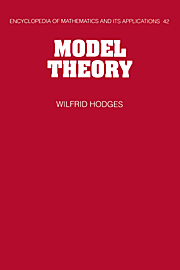Book contents
- Frontmatter
- Contents
- Introduction
- Note on notation
- 1 Naming of parts
- 2 Classifying structures
- 3 Structures that look alike
- 4 Automorphisms
- 5 Interpretations
- 6 The first-order case: compactness
- 7 The countable case
- 8 The existential case
- 9 The Horn case: products
- 10 Saturation
- 11 Combinatorics
- 12 Expansions and categoricity
- Appendix: Examples
- References
- Index to symbols
- Index
9 - The Horn case: products
Published online by Cambridge University Press: 08 October 2009
- Frontmatter
- Contents
- Introduction
- Note on notation
- 1 Naming of parts
- 2 Classifying structures
- 3 Structures that look alike
- 4 Automorphisms
- 5 Interpretations
- 6 The first-order case: compactness
- 7 The countable case
- 8 The existential case
- 9 The Horn case: products
- 10 Saturation
- 11 Combinatorics
- 12 Expansions and categoricity
- Appendix: Examples
- References
- Index to symbols
- Index
Summary
Fair maid, white and red,
Comb me smooth, and stroke my head;
And every hair a sheave shall be, And every sheave a golden tree.
George Peele, The Old Wife's Tale (1595).Direct products are everywhere in algebra. They are the first general form of construction that the student meets – thanks to groups and vector spaces. From rings to automata they are part of the everyday scenery.
Why do so many types of mathematical object allow this construction? G. Birkhoff gave part of the answer when he showed that every class defined by identities is closed under direct products. J. C. C. McKinsey showed the same for classes defined by universal Horn sentences. A. I. Mal′tsev pointed out the intimate link between direct products and another common construction with a quite different history: presenting a structure by generators and relations.
Once these basic facts about direct products are established, we can set out in at least three directions. First, there is plenty more to say about generators and relations. They can be used to describe not just single structures, but constructions taking one class of structures to another. Many well-known constructions (such as tensor products and polynomial rings) have this form, and we can study the logical features which they share. This topic has recently had a shot of adrenalin through the development of software specification languages based on ‘initial semantics’.
The second useful direction is the study of other constructions based on direct products.
- Type
- Chapter
- Information
- Model Theory , pp. 412 - 477Publisher: Cambridge University PressPrint publication year: 1993



